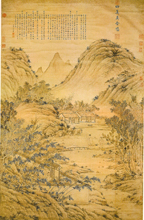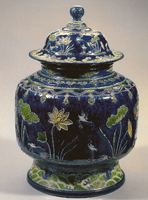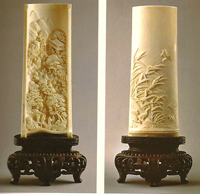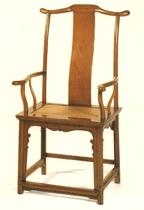Dr. Wei Yang's Blog (2017)
August 12, 2017: Today, New York Times published a very interesting story about the dilemma of donating art to museum or a charitable organization. Paul Sullivan, the author of Even for Collectors, Donating Art to a Museum Can Be Tough," addresses a few important issues on donation. Most collectors make donations to enjoy a tax deduction. If the work goest to a museum, the donor gets the full deduction. If the art goes to a nonprofit where art is not central to this mission, the donor is eligible for only the value of the piece when it was purchased. Sullivan concludes that donating art to a museum is complicated, easy or difficult? depending on what you are donating and to whom you are donating. 1) Any museum would say "Thank you, thank you and thank you," if you donate a Picasso worth $6 or $7 million. 2) The donation would be easier when a museum asks for it first. 3) An average donation is difficult to get approval. In other words, being turned donw is a reality. 4) The musuem might ask for additional money in the form of an endownment to accept your art. 5) Museums are concerned about provenance or authenticity. As an art historian myself, I understand and support the musuem's stand on these issues. I firmly believe that 1) A museum should be selective by accepting only works of quality and rarity. 2) A museum should be self-sufficient by asking for some financial assistance with storing your art of average quality. 3) A musuem should honor the patrimony laws that protect artifacts. Art professionals offers some practical solutions to ease your donation stress: 1)donating to charities where the art may be displayed or sold to finance projects; 2) donating to a midsize regional musuem where your works will be a focus.
I am constantly asked to explain how to gain access to Christie's and Sotheby's for representation. Believe me, the consignment process is very complicated, and I wish I could summarize the key issues, ranging from seller's commissions, advertising fees, insurance, loan, to guarantee and advances, in a few sentences. Before you approach an auction house, I would encourage you to read as much as possible on how an auction house accept consignment. Once you understand how Christie's and Sotheby's approach a desirable consignor, make a consignment proposal, and how Christie's and Sotheby's compete for quality consignment, you will handle any auction house consigment issues with confidence. If you do have a desirable art work in your possession for sale, I would encourage you to read Kelly Devine Thomas' Christie's and Sotheby's: On the Champagne Trai (2005) before you call the auction house.
"How much is my art worth?" One client told me that his great grandfather purchased a painting in China when he was in service in the 1940s. The painting was signed by a famous artist of the 16th century and appraised for $20,000 in 2007. The owner believed that the value of his painting would go up a lot since 2007. He wanted at least $20,000 for his painting. However, he couldn't sell it. Christie's and Sotheby's showed no interest in consignment. He also had no luck with dealers and other 2nd tier auction house. The owner couldn't understand why he couldn't get his painting sold, why Christies and Sotheby's were not interested in his precious painting. What would you recommend? he asked me. I examined the painting in person, reviewed the previous appraisal, and shared my thoughts with him. Here is my report.
Issue 1: Authenticity and Quality -- The subject painting is likely not an original work by the signed artist but a work by a less capable hand. In my professional opinion, the painting does not comply with the signature features characterized the original works of the the signed artist, ranging from iconography, the calligraphic style of his signature, the character formation on his name seals to the shading techniques or brushstrokes favored by the signed artist. Visual discrepancies are too striking to be original. The quality of the painting is average.
Issue 2: Value & Valuation of Art--The appraiser who appraised the painting for $20,000 in 2007 made a few mistakes. Mistake I: He appraised the painting as an original and used highly-priced comprables (originals) in his valuation. He should have used the sales data of less authentic works in the category of "attributed to," "in the manner of" "after" or "reproduction," etc. Mistake II: He didn't rank the new artist who created this painting in the name of a well-knownn artist among his equals before qualifying comparables. Mistake III--He used old sales data (2001-2004, the peak market) to reflect the market appreciation of the original artist and his works in 2007, a declined market. He didn't address how the changed market had affected the value of the painting in question. In this valuation, authenticity, rank of the artist, quality of art work, selection of comparables from their most appropriate market places are key factors. The appraiser's focus on the higher sales prices realized by original paintings sold at 1st tier China-based auction houses is also troublesome, since an objective analysis of both favorable and unfavorable market sales data is the base for a fair value esitmate. Therefore, the value conclusion reported by the 2007 appraisal needs to be up-dated to reflect the market appreciation of the painting in 2013.
This particular case taught us two lessons. Lesson 1-- A proper identification of your art work is crucial to value. Although art appraisers do not authenticate an art work, we are obligated to determine the authenticity of an art work and its quality in question before we render a value opiniion. Lesson 2 --the use of appropriate market data from the most relevant market is a priority in our market research. Understanding the current market trend in the light of historical references is also part of an art appraiser's responsibility.
The Sunday Dialoge on "What is That Art Worth?" (2013) published by The New York Times discussed the skyrocketing prices in today's art market. As a Chinese art adviser & art historian appraiser, I have been asked many times if an art work sold at an auction house is worthy more. I often don't have a perfect answer, since a responsible explanation should be more than just a few sentences. Here is Michelle Marder Kamhi's response: "Today's art market has nothing to do with art and everything to do with hype." William Cole argues that "...if artworks sell at exorbitant prices, those works-and the artists who created them-become newsworthy, regardless of whether they're actually any good and the media play right along, almost never questioning the quality of the works or the abilities of the artists." The humorous voice of Bruce Hatton Byer is amusing: "So let the billionaires spend what they will on contemporary art. I am confident that their broke heirs will wonder why they didn't buy government bonds when they had the chance." Thus, don't be upset if you cannot afford the artwork offered by auction houses. Don't be disappointed if you have experienced some difficulties in selling your art work at an auction house. If your art work is of high quality by a capable hand, the art market will eventually appreciate it.
Appreciating the expertise of a qualified professional is essential. When art owners, insurance agents, auction professionals and dealers approached me for information about an art work, in most cases, inquires focus on authenticity and value. They simply want my free feedback. Free is good but no so good for art consultation. Why? expecting a highly trained art professional (Ph.D in Chinese art, M.A. in Asian Buddhist Art & Accredited Senior Appraiser of Asian Art) to hand you the information at no cost for you is unlikely. Like everybody else, art professionals work for a living. We understand the financial pressure from engaging a professional for guidance, since cutting down the cost is on everybody's wish list. However, those who made these thoughtless demands might forget that independent art professionals don't receive a monthly salary from a museum or university for our expertise and services. Art professionals are often loaded with tremendous amount of inquiries just like yours everyday. Our priority is to serve our paid clients to the best of our abilities.
It doesn't take a gunius to figure out the benefits of engaging quality professional services. In the real world, quality professional service always comes with benefits and advantages. For example, once I was consulted on a damaged pottery horse of the 8th century for insurance claim. The pottery horse was originally insured as a Tang sancai horse (618-907). For the insurance agent, engaging a professional appraiser to arrive at a fair replacement value should be the objective. For the object owner, a replacement appraisal prepared by a qualified appraiser should give you a sense of fairness in the insurance settlement. To complicate the insurance procedure, my findings contradict the original identification of the subject horse. Judging from the material used, the portrayal of the horse and the ornamentation, I identified the horse a fake of the 20th century, a decorative piece. If the insurance company or the art owner had engaged a qualified Asian art appraiser for insurance coverage in the first place, the pottery horse should be insured properly and the owner could have avoided the deep insurance premium. If both parties recognized the merits of quality professional services, they could avoid the reappraise of the property for insurance settlement and expensive legal cost to get a fair settlement. It is common knowlege that the legal expenses are significant bigger than the appraisal fee of a quality art appraiser.
Every decision entails consquences, good or bad. In the complicated Asian art field, saving a few hundred dollars on an appraisal may cost you either a short sale or a lot more on the legal representation. A misidentification of an art work and a less accurate value estimate can be very costly in the real world. Therefore, seeking quality professional advice is a wise approach, since any specialized knowledge or privileged information are the result of long-term special trainning and studies, which cannot be given out for free.
Dr. Wei Yang's Blog (2012)
Art Value, Market & Appraisal
The most important thing to remember is that no matter what your plan is, understanding what you have or what you need to accompolish is the top priority. Educating yourself about the current art market and possessing sound information are fundamental to the accomplishment of your ultimate goal. Seeking professional advice or commissioning an art appraisal from a qualified art expert is crucial.
Today, either selling or buying a fine art work is more difficult than ever. For sale, almost everybody finds it difficult to initiate a sale in the current art market. A lot of art owners have no clue where to start. Many people begin by contacting famous auction houses for consignment, but very few owners receive a helpful response—sometimes no word at all. Others spend hours and hours on the internet without any concrete results. For purchase, if your budget does not allow you to engage Christie's and Sotheby's services, you need to deal with the uncertain authenticity of art works offered at other market places. You are left alone with all purchaser's responsibilities, ranging from identification, authenticity and value estimate. You may wonder, does the art work I like really worth that much? Do I get a bargin price for what I buy from a regional agent or dealer? Many art seller and buyers end the process flat, since it costs them too much time, energy and emotion. Is it too hard to find a new home for my art work? Where can I find somebody who can guide me through the process? Is my art work worth the time and money I spend on an appraisal? Nobody wants to spend hard-earned money on an art object that is of very limited value or no value. Do these frustrations sound familiar to you? In order to target these practical issues and provide art owners with guidance and options, Asian art specialists of WEI YANG ART are committed to listen to your concerns and offer feasible solutions to your problems at the minimum cost.
WEI YANG ART is a professional Asian Art Consulting and Appraisal Firm located in Princeton, NJ, U.S. We aim to provide our clients with the information they need, the services they desire, and the advice they deserve at the minimum cost. We pledged to follow the regulations and comply with the code of ethics for appraisers in our Asian art consultation and appraisal practice.
If you need expert assistance, Please Contact Us or call us at (609) 688-6891.
We Consult & Appraise Asian Art












